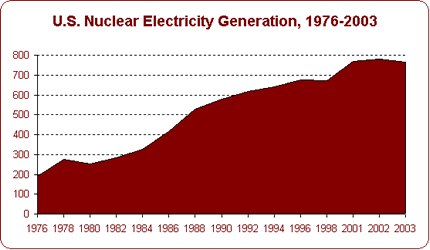
Nuclear Power Generation
The burning of fossil fuels (coal, oil, and gas) has been used to generate electricity since before the turn of the twentieth century. For over three decades, however, a non-fossil fuel, uranium, also has been used to produce electricity. The first U.S. nuclear power plant went into commercial operation in 1957 at Shippingport, Pennsylvania. Since then, the use of nuclear-generated electricity has grown substantially in the United States.
The U.S. nuclear power industry achieved its fourth consecutive year of record power generation levels during 2002. Total nuclear output was 780.1 billion kilowatt hours, about 1.5 percent above the previous record of 768.8 billion kilowatt hours set in 2001. This represents continued growth in an industry that was producing less than 600 billion kilowatt hours per year prior to 1991. The record was achieved despite the fact that the total number of commercial reactors has dropped from 111 reactors (in 1990) to 104 reactors now. The record was attained through increased use of existing nuclear capacity. The estimated annual net capacity factor was 90.7 percent during 2002 compared to 89.4 percent in 2001 and 66 percent in 1990.

Nuclear generation surpassed 700 billion kilowatt hours for the fourth consecutive year. The nuclear industry generated 71.1 billion kilowatt hours in January 2002, the highest level for the U.S. nuclear power industry ever.
Nuclear power plants rely on the process of nuclear fission. In this process, the nucleus of a heavy element, such as uranium, splits when bombarded by a free neutron in a nuclear reactor.(1) The fission process for uranium atoms yields two smaller atoms, one to three free neutrons, plus an amount of energy. Because more free neutrons are released from a uranium fission event than are required to initiate the event, the reaction can become self sustaining--a chain reaction--under controlled conditions, thus producing a tremendous amount of energy.
Uranium occurs in nature in combination with small amounts of other elements. Economically recoverable uranium deposits have been discovered principally in the western United States, Australia, Canada, Africa, and South America. A ton of uranium ore mined in the United States yields about 7 pounds of uranium oxide (U3O8). Uranium ore must be chemically processed, enriched, and formed into pellets before it can be used as a fuel.
Uranium fuel pellets are loaded into hollow tubes called fuel rods. Hundreds of fuel rods form fuel assemblies that, along with control rods, are placed into a nuclear reactor core and then submerged in water. Like fossil fuels, the resulting uranium fuel produces heat that turns water into steam. The steam turns blades in a turbine connected to an electrical generator. However, heat is produced differently in a nuclear reactor than in a fossil fuel power plant.
The nucleus of an atom consists of combinations of protons and neutrons--each of about equal weight. Energy in a nuclear reactor is derived from a process called nuclear fission, in which a neutron strikes the nucleus of a uranium atom and is absorbed. The absorption of the neutron makes the nucleus unstable, causing it to split into two atoms of lighter elements and release heat and new neutrons. The heat is used to produce electricity, while the neutrons can potentially be absorbed by other atoms of uranium, resulting in more nuclear fissions. This continuing process of fissioning is called a chain reaction. It is sustained because, for every atom of uranium fissioned by a neutron, new neutrons are released to continue the process.

The nucleus of an atom consists of combinations of protons and neutrons--each of about equal weight. Energy in a nuclear reactor is derived from a process called nuclear fission, in which a neutron strikes the nucleus of a uranium atom and is absorbed. The absorption of the neutron makes the nucleus unstable, causing it to split into two atoms of lighter elements and release heat and new neutrons. The heat is used to produce electricity, while the neutrons can potentially be absorbed by other atoms of uranium, resulting in more nuclear fissions. This continuing process of fission is called a chain reaction. It is sustained because, for every atom of uranium fissioned by a neutron, new neutrons are released to continue the process.
The United States has 98.2 million kilowatts of nuclear capacity, more than any other nation in the world. France ranks second, third is Japan, and fourth is Germany. International growth in commercial nuclear power has slowed, but several countries have ambitious nuclear construction programs. While no nuclear reactors have been ordered in the United States since 1978, China, India, Russia, and South Korea and other countries have brought new reactors into service during the current century.
Concerns about issues such as high-level waste disposal, decommissioning
expenses when reactors are retired, and the use of nuclear reactors to relieve
possible global warming associated with fossil fuel-based generation will
influence the future level of growth of nuclear power worldwide.
More information on this subject may be found in the EIA publications: Monthly Energy Review, Annual Energy Review and Nuclear Power Generation and Fuel Cycle Report.
Need Help Now?
Call the National Energy
Information Center (NEIC)
(202) 586-8800 9AM - 5PM eastern time
Specialized Services
from NEIC
If you are having technical problems with this site, please contact the EIA
Webmaster at wmaster@eia.doe.gov